Feature image of trans video game characters from Chrono Trigger, Final Fantasy VIII, Leisure Suit Larry 6, Final Fight, Super Mario Bros 2, and Final Fantasy V
For as long as I can remember, escaping into imaginary worlds full of adventure, magic, and fantastical beasts in novels and comic books has been one of my all-time favorite pastimes. But as much as I love to read, I really love to game. My first video game console was a broken PlayStation 1 passed down to me by my older brother. The only games I had were Spyro and Ready 2 Rumble Boxing. Spyro is still one of my favorite games today — that purple dragon has a special place in my heart — but Ready 2 Rumble let me live out another fantasy. While I have never had any interest in boxing or any other athletics, in this game I could play as a female character, and no one could stop me. At school, I got made fun of for being too feminine, but in video games, I could just be the girl I’ve always known myself to be. Shoutout to Sony for being my first ally.
Every trans person finds some way to express themselves before they find an accepting environment. For many of us, video games were that outlet. Today we live in a world where video game publishers create canonically trans characters, but what about before the Transgender Tipping Point? What about before I was even born?
I did a deep dive on all the retro video game characters that fans believe to be trans. I searched through Reddit, Tumblr, YouTube, and everything in between. I expected to only find a few characters, but I underestimated the nerdiness of our community. We’ve laid claim to a ton of people throughout the 80s and the 90s, and I love that for us. I also found quite a few trans characters were created for humorous purposes. I don’t love that. Whether we’re claiming a beloved, aspirational character or simply being mocked, the following characters are proof we’ve always been in the vast world of gaming.
Birdetta AKA Birdo – Super Mario Bros 2 (July 1987)

The first canonically transgender video game character is Birdetta who is also known as Birdo. Debuting as “Catherine” in the Japan-only PC game Yume Kōjō: Doki Doki Panic from Nintendo, Birdetta was described in the game manual as “a man who thinks of himself as a female.” When the game was re-released in September 1988 in North America under the name Super Mario Bros 2, the game manual stated “He thinks he is a girl and spits eggs from his mouth. He would rather be called ‘Birdetta.” This insensitive language is very representative of the 80s, a time where many people were aware of trans women but invalidated our existence. Today Birdetta is seen as a trans icon in many gamer spaces, and she is still a major part of Mario’s pantheon of characters.
Tessy LaFemme – Caper in the Castro (May 1989)
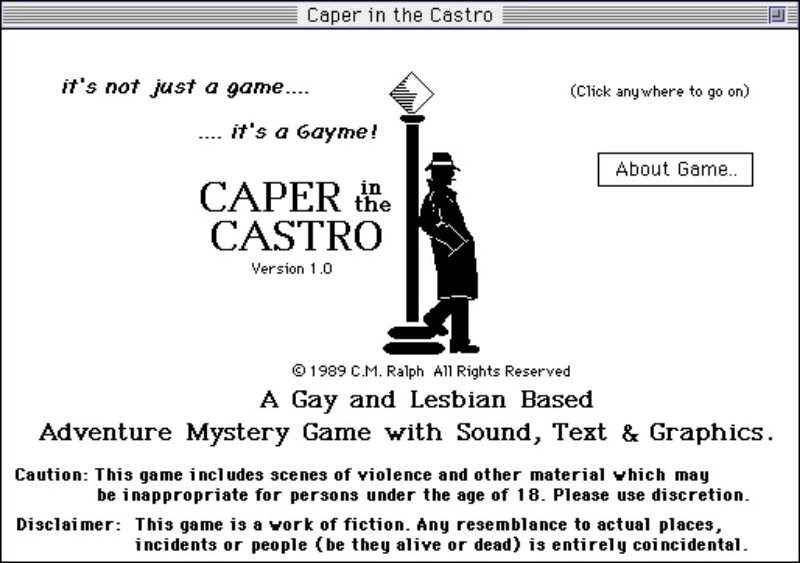
In May 1989, C.M. Ralph created the first known video game with queer and trans themes. This point-and-click, murder mystery game follows Tracker McDyke, a lesbian private detective, as she searches San Francisco’s historically queer Castro district for her kidnapped friend, a trans woman named Tessy LaFemme. Ralph released Caper in the Castro as charityware and spread it through early bulletin board messaging systems. The game came with a short message asking people to donate to an AIDS charity of their choice. For years, the game was thought to be lost, but in 2017, an emulated version of the game became playable through Internet Archive.
Poison – Final Fight (November 1989)
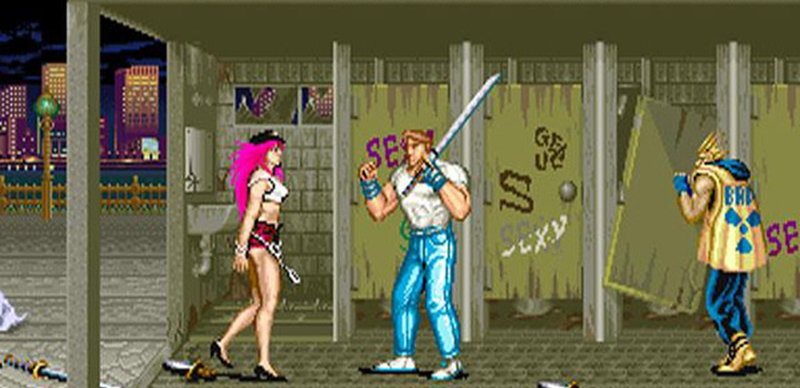
Anyone who has gone to a video game arcade knows about Street Fighter. Created by Takashi Nishiyama, Hiroshi Matsumoto and Japanese video game company Capcom, this is one of the highest-grossing franchises in the world. In November 1989, Final Fight, a spin-off game, was released. Beat ‘em up games usually consist of buff men brawling with other men, but Final Fight was a game changer for gender representation with Poison, a non playable character (NPC), that players go up against. Poison was introduced as a member of Mad Gear, an enemy gang, in Final Fight, and her gender has been a long-time debated topic.
As game developers prepared to release Final Fight in the United States, there were concerns about how beating up a woman would be perceived. Poison and her palette-swapped gangmate Roxy were deemed “newhalf” which is derogatory Japanese slang for trans women. This change in character origin is obviously transphobic, for it implies that hitting a transgender woman is the same as hitting a cisgender man. When the game made it to Super Nintendo, a playtester in the States complained about the protagonist hitting women which led to the removal of Poison and Roxy. Capcom has since tried to retcon the origin story for these two by describing them as trans women who have undergone gender-confirmation surgery, crossdressers, and cis women. Street Fighter producer Yoshinori Ono stated, “Let’s set the record straight: in North America, Poison is officially a post-op transsexual. But in Japan, she simply tucks her business away to look female.”
Like a lot of trans women, people can’t seem to make up their mind on whether or not they see her as a legitimate woman and have a lot to say about her body. The controversy surrounding this fictional character isn’t all that dissimilar from any trans woman in the spotlight.
Yasmin – Circuit’s Edge (1989)
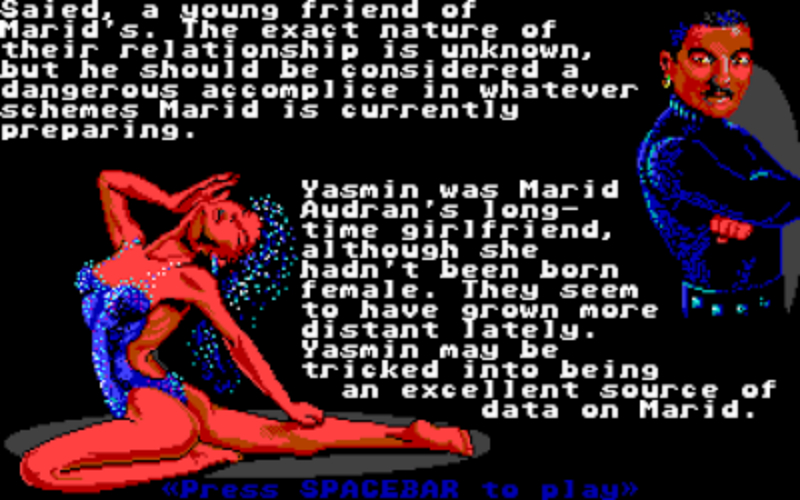
Developed by Westwood Associates and released by Infocom in 1990, Circuit’s Edge is a point-and-click adventure game based on the novel When Gravity Fails by George Alec Effinger. In this game, players follow Marîd Audran, a private detective, as he goes on a cyberpunk, dystopian journey through the Budayeen, a lively quarter of a fictional Middle Eastern city. During the game’s first quest, players meet Yasmin who is described as Audran’s “long-time ex-girlfriend, although she hadn’t been born female.” Audran uses her as a source of information. While Yasmin has no further appearances, other characters are specified as trans throughout the game.
Frozen Half – Akumajō Special: Boku Dracula-kun (1990)
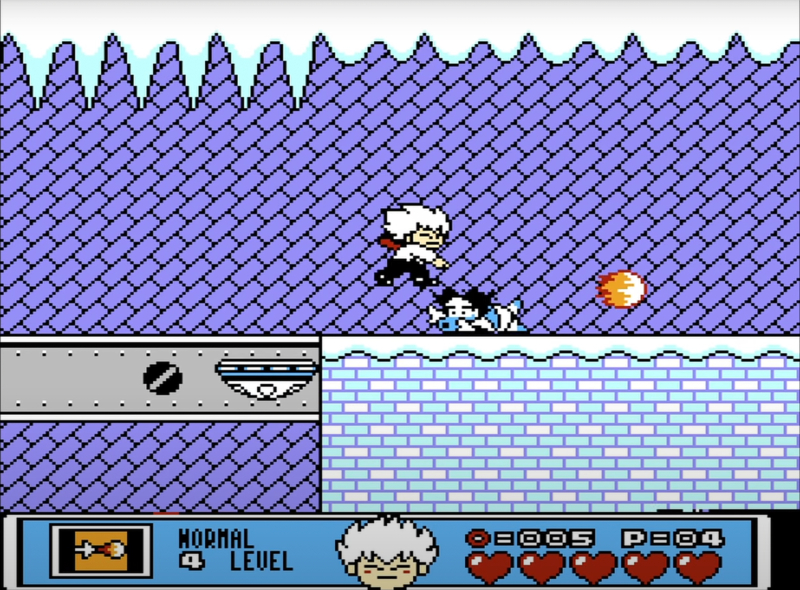
Released by Konami, Akumajō Special: Boku Dracula-kun created for the Nintendo Entertainment System (NES) which is known in Japan as the Famicom. It follows self-proclaimed Demon King, Kid Dracula, as he wakes up from a long term sleep and learns that he’s been challenged by a demon named Galamoth. Kid Dracula journeys through Castlevania to go after Galamoth and fight Galamoth’s army. During the ice stage of the game, Galamoth’s servant, Frozen Half, attacks Kid Dracula. In the game manual, she is described as okama, Japanese slang that can refer to trans women, gay men, and/or crossdressers depending on the context. When Frozen Half later appears in 1991’s Castlevania: Symphony of the Night, she’s described as “newhalf” and has had a redesign where she appears more traditionally feminine.
Various Characters – Rex Nebular and the Cosmic Gender Bender (1992)
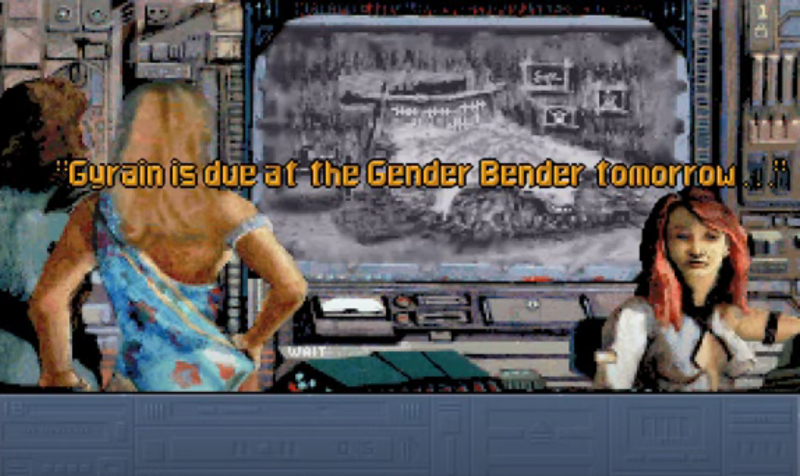
Before Y: The Last Man there was MicroProse’s Rex Nebular and the Cosmic Gender Bender. In this point-and-click adventure game, players follow the titular protagonist Rex as he searches for a missing vase on Terra Androgena, a strange planet that seems to be solely inhabited by cis women. To continue procreation, the women on the planet created a machine, the Cosmic Gender Bender, to change their sex for short periods of time. One could argue that this game is full of trans people since the inhabitants swap genders at random. According to blogger Martin Smith of TransmitHim!, the game’s biggest challenge is putting up with “out-dated, casual chauvinism and transphobia.” Sounds like a regular Tuesday to me.
Faris Scherwiz – Final Fantasy V (1992)
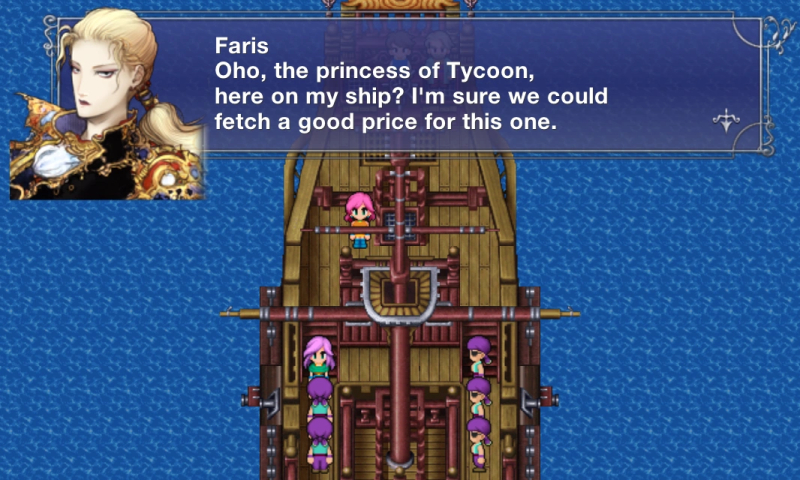
The Final Fantasy franchise is beloved by many trans and queer people. I’m a huge fan myself, so when I learned there was a gender nonconforming character from the early 90s, I flipped out. In 1992, Japanese video game publisher Square (succeeded by Square Enix) released Final Fantasy V for Nintendo’s Super Famicom which is known internationally as the Super Nintendo Entertainment System. Born Princess Sarisa Scherwil Tycoon, Faris was lost at sea and raised by pirates to be a boy. Faris goes back and forth between masculine and feminine pronouns and wears masculine clothing. Many fans have claimed Faris as a trans or nonbinary character while others see Faris as a masculine woman. Either way, she is the first known playable gender nonconforming character in a video game.
Shablee – Leisure Suit Larry 6 (1993)
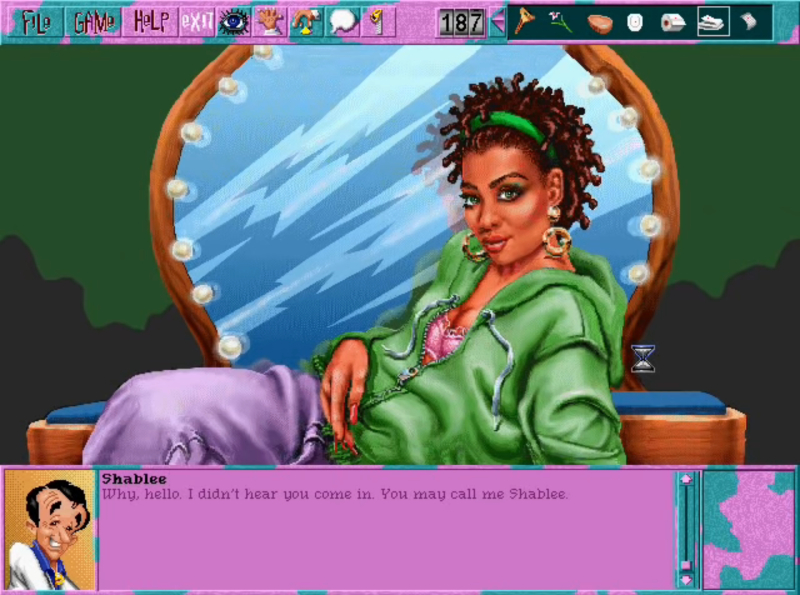
The Leisure Suit Larry franchise consists of 10 releases and three remasters where users play as titular character Larry Laffer, a middle-aged cis white man with no game. In these adult-themed sex comedy games, Larry attempts to seduce young women with few success stories. Leisure Suit Larry 6, like the five releases before, is a PC point-and-click game, but in this edition, players meet Shablee – the first Black trans character in a video game. She is a “dark-skinned makeup artist” Larry meets at a resort. After the two hang out, they begin to hook up and Larry learns Shablee is trans. When he pulls out a condom, Shablee takes it and puts it on her own penis instead. Larry has a violently transphobic reaction to her reveal which prompts the game to misgender her by referring to her with masculine pronouns. After her reveal, the narrator of the game quips, “No wonder Shablee knows what a man likes” in the classically transphobic “gotcha!” action that ruled the 80s and 90s.
This was the most disheartening discovery I found during my research. The first Black trans character in a video game was created to be ridiculed and then discarded by society. Larry throws up after seeing Shablee’s erect penis and is seen washing his mouth out the following morning because he kissed her. The scene is reminiscent of Stan (Evan Peters) in season one of Pose who washed his mouth out after kissing Angel (Indya Moore). Shablee represents so many of the girls who never made it beyond the 90s because a man they came across couldn’t handle their attraction toward them. Shablee represents our fallen sisters of yesteryear like Rita Hester, Venus Xtravaganza and Dorian Corey. In many ways, Shablee represents me and the girls of today. We are all just trying to live our best lives, but the bigots of the world rather see trans women as punchlines in their own stories as opposed to fully realized human beings with something to offer. There is no mention of Shablee after her date with Larry, but I like to imagine she found a man actually worth her time.
Boethiah – The Elder Scrolls: Arena (1994)

The first game in the Elder Scrolls series, The Elder Scrolls: Arena was released in March 1994 for Microsoft. This open-world RPG fantasy game takes players on an adventure through Tamriel, a large continent full of various cultures, magical creatures and supernatural forces. Arena was one of the first games with a realistic day/night cycle with shops closing at sunset and streets clearing at night when monsters roam until morning. Throughout the series of monster-fighting quests, players meet Boethiah, a Daedric Prince, who shifts between female, male and genderless personas. Boethiah is another character with a debated gender history. I think it’s pretty fair to call Boethiah nonbinary.
Flea – Chrono Trigger (1995)
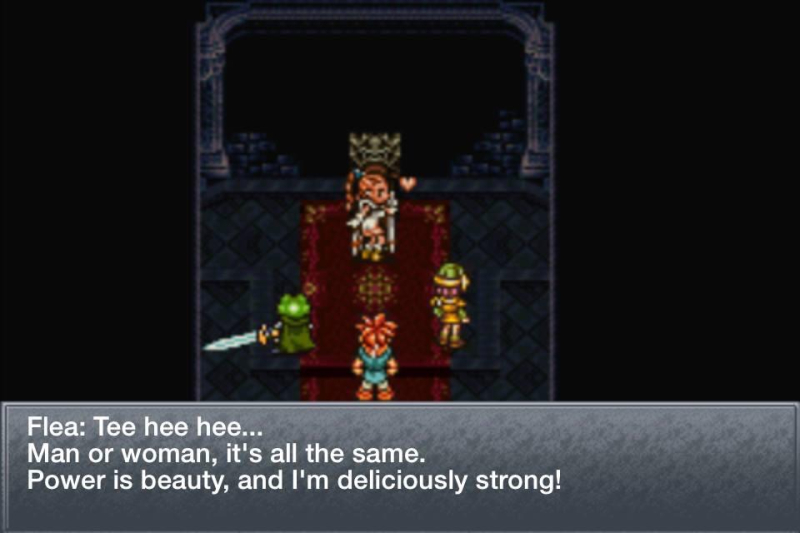
Developed and published by Square, Chrono Trigger was released for Super Nintendo and is the first game of the Chrono series. As of March 2003, Chrono Trigger was Square Enix’s best-selling game with nearly 2.7 million units shipped. This RPG allows players to time travel to different eras from prehistoric to the Middle Ages and a post-apocalyptic future. Throughout their quests, characters battle enemies, make friends, gain allies and obtain magic. One of the boss characters is Flea whose gender has been interpreted differently by many players. In the game, characters refer to Flea as a woman, but Flea says, “Male… female… what’s the difference? Power is beautiful, and I’ve got the power!”
Sheik – The Legend of Zelda: Ocarina of Time (1998)
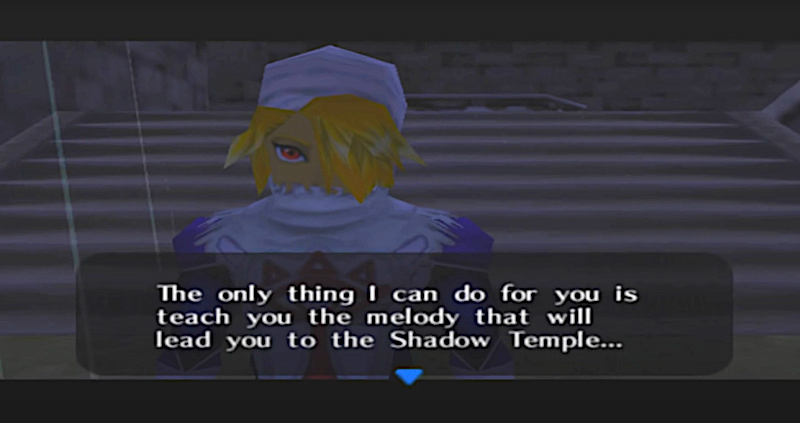
Zelda has a fierce queer and trans fanbase. Many fans of the franchise have argued that the main character Link is trans. Others have made an argument for Princess Zelda herself because of her alter ego. In 1998’s The Legend of Zelda: Ocarina of Time, Princess Zelda goes into hiding as a boy named Sheik to get away from Ganondorf, a tyrant, and to guide Link during his quest. Some argue that Sheik is trans because Zelda used magic to change herself, but other people believe it was just a change of clothing. Either way, it’s giving gender nonconformity, and we love that. Welcome to the Alphabet Brigade!
Adel – Final Fantasy VIII (1999)
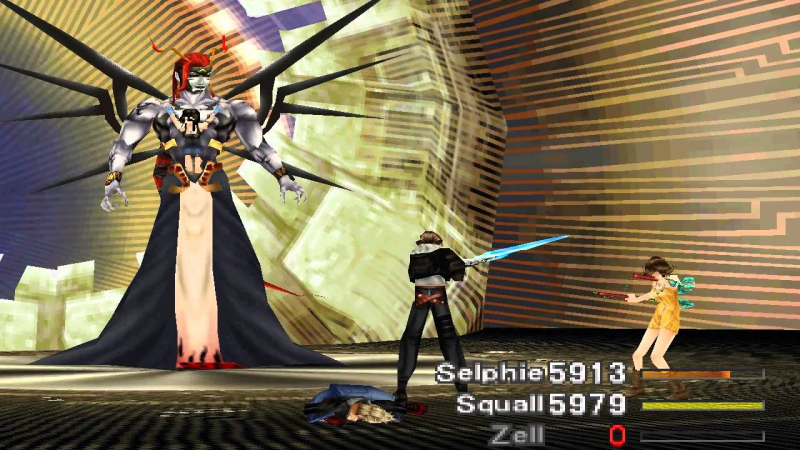
Many characters in the Final Fantasy franchise have been speculated to be trans or gender nonconforming because of their appearance. Adel is a special case. In 1999’s Final Fantasy VIII, players come face-to-face with a powerful sorceress who has caused a lot of confusion for people in the fandom. While the game indicates that only women can be sorceresses and Adel searches for a girl to be her successor, her pronoun usage shifts depending on the language used. In the original Japanese dialogue, no gender is indicated. In English, feminine pronouns are used. In French, both masculine and feminine pronouns are used. In the Italian version of the game, she is given the feminine name spelling “Adele.” I began looking through game forums, and I quickly exited each one because the transphobia was too much to handle. Whether or not Adel is canonically trans is irrelevant, she’s a fan favorite for being a certified badass.
HONORABLE MENTION: Samus Aran – Metroid (1986)
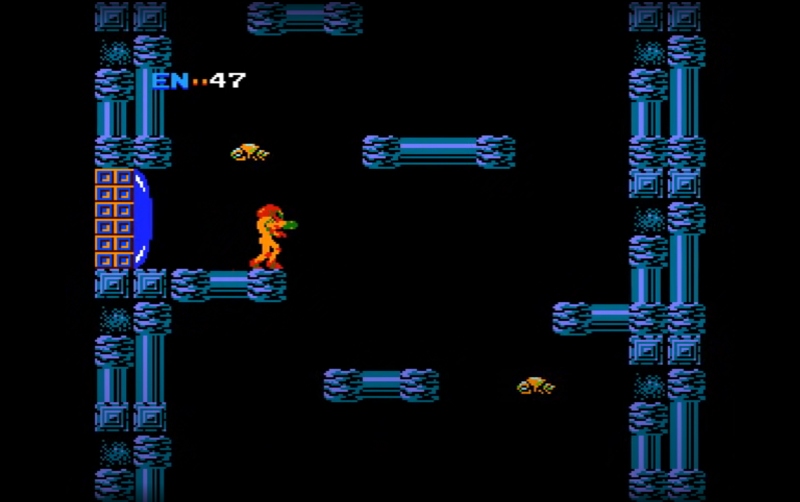
I debated including Metroid’s Samus Aran on this list. Out of all of my findings, Samus Aran has caused the most heated gender debates I’ve seen over a fictional character. In 1986, Nintendo released Metroid, the first mainstream video game featuring a playable female character, as stated by Guinness World Records in 2013. In 2015, The Mary Sue published “Metroid’s Samus Aran is a Transgender Woman. Deal With It.” which sparked a lot of controversy. The article currently has around 2300 comments. In 1994, the game developers were asked by the writers of the official strategy guide of Super Metroid if Samus had any secrets. Hirofumi Matsuoka worked on the original design for Samus and claimed she “wasn’t a woman” but actually “newhalf.” Since then there has been discussion on whether or not to take this offensive commentary seriously. For many fans, this is enough which would make Samus Aran “canonically a 6 foot 3 transgender woman,” as Twitter user JinkiesJerrica stated. The people stating that she isn’t trans are going off physical characteristics which feels pretty transphobic.
Trans people exist in every form of media, and we always have. In video games, like in film and television, a great deal of our past representation was created with malice. But despite these poor intentions, we reclaim our narratives with pride.
Hopefully Nintendo will give Samus a coming out party one day soon. Either way, I think I’ve found my next cosplay idea.
This piece is part of our 2023 Trans Awareness Week coverage. Our Senior Editor, Drew Burnett Gregory, felt like cis people were plenty aware of trans people in 2023 thank you very much, so this week trans writers will be taking us back into recent history — specially post-Stonewall (1970) to pre-Tipping Point (2013).



This was fantastic!! I had no idea there was so much trans history in video games. Thank you for sharing this piece.
Ah, this brought back memories. When I was in college, a professor I was friends with asked me for some help. She was teaching class on LGBTQ+ representation in media, but she didn’t know anything about video games. I think she wanted a few characters she could talk about, but I went a bit overboard and started charting the whole course of LGBTQ+ representation in video game up to that point and ended up giving her pages of material to pick from. Some friends even thought I should press on with it, but it got sidelined and eventually forgotten as I had my actual degree coursework to worry about.
That said, there are a couple entries on this list that I’m sure weren’t on mine, so I definitely missed a few. Nicely done and well written!
I never really read Faris as Non-binary or Trans, once she’s outed as being a woman that’s how she identifies for the rest of the game and every character met afterwards immediately knows and identifies her as a woman with no pushback. I don’t know, I just don’t see what other people see.
Wow. Reading this was a lot more emotional than I was expecting. Thank you for this!
Gonna have to go back and play Chrono Trigger again!
Where where is Vivian from paper Mario?
Ultima 3, you made your own characters, and were given the three choices of male, female, other. 1983. Although unfortunately it is the only game in the series to do so